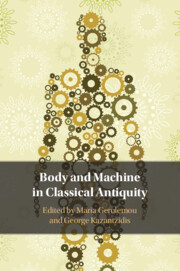Book contents
- Body and Machine in Classical Antiquity
- Body and Machine in Classical Antiquity
- Copyright page
- Contents
- Figures
- Contributors
- An Introduction to Body–Machine Intersections
- Part I Blended Bodies
- Chapter 1 More Than a Thing
- Chapter 2 Automata, Cyborgs, and Hybrids
- Chapter 3 Not Yet the Android
- Part II The Technological Body
- Part III Towards the Mechanization of the Human Body
- Index of Passages
- General Index
- References
Chapter 1 - More Than a Thing
Figuring Hybridity in Archaic Poetry and Art
from Part I - Blended Bodies
Published online by Cambridge University Press: 13 July 2023
- Body and Machine in Classical Antiquity
- Body and Machine in Classical Antiquity
- Copyright page
- Contents
- Figures
- Contributors
- An Introduction to Body–Machine Intersections
- Part I Blended Bodies
- Chapter 1 More Than a Thing
- Chapter 2 Automata, Cyborgs, and Hybrids
- Chapter 3 Not Yet the Android
- Part II The Technological Body
- Part III Towards the Mechanization of the Human Body
- Index of Passages
- General Index
- References
Summary
This chapter starts by exploring the familiar scene at the end of Iliad 18, where the Homeric poet describes a sequence of artefacts that Hephaestus has manufactured: first the self-moving twenty golden tripods that he is in the process of completing, now fitting them out with ‘ears’, then the golden girls, automata, who are filled with ‘voice and strength’, then twenty self-blowing bellows that keep the fire strong, and finally Achilles’ wondrous shield, filled with individuals, animals and other elements that move, speak, sing and grow before our eyes for all (as the poet takes pains to remind us) that they are metal-forged. The Odyssey introduces another set of Hephaestus-forged animated metal goods, the guard dogs standing on the threshold of Alcinous and described in book 7.91–4. The second part of the chapter explores some of the vivified objects that populate archaic hexameter poetry, hybrids that stand at the interstices between the living and inanimate and among which the Hesiodic Pandora claims a place together with several other Hesiodic beings. The discussion’s second half focuses on the late archaic and early classical period, and on a number of figures that appear in Pindaric poetry.
Keywords
- Type
- Chapter
- Information
- Body and Machine in Classical Antiquity , pp. 19 - 47Publisher: Cambridge University PressPrint publication year: 2023
References
- 1
- Cited by

